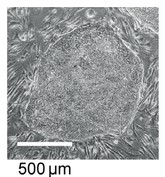Question
The graph shows the distribution of photoreceptors in the retinas of humans and mice. Distances from the centre of the retina (0°) are expressed as visual angles. The image shows the position of the optic nerve.

(a) Outline one reason that no data is shown at the position of the optic nerve.
(b) Suggest whether the data in the graph shows that mice have better colour vision than humans.
(c) Outline the role of bipolar cells in the retina.
(d) Distinguish between chemoreceptors and mechanoreceptors, including an example of each.
Answer/Explanation
Answer:
(a) there are no photoreceptors/cones/rods
OR
it is the blind spot;
(b)
a. mouse has greater photoreceptor density (than human);
b. the graph does not distinguish between types of photoreceptor;
c. cones detect colours
OR
rods provide monochromatic/night vision;
d. there is no data about colour vision in mice;
(c)
a. bipolar cells interconnect/link photoreceptors to ganglion cells
OR
bipolar cells pass impulses from photoreceptors to ganglion cells;
b. one bipolar cell receives signals from/synapses with one cone cell;
c. one bipolar cell receives signals from/synapses with several rod cells;
(d)
a. chemoreceptors stimulated by chemicals but mechanoreceptors are
stimulated by movement/forces/pressure;
b. valid example of each;
Question
An oval-shaped stem cell cluster is shown in the micrograph.
(a) State the main characteristic of stem cells.
(b) Calculate the maximum diameter of the stem cell cluster on the micrograph, showing
your working and giving the units.
(c) State one therapeutic role of stem cells.
(d) Discuss how the use of stem cells to treat hereditary diseases could affect the person
who received the treatment and their progeny.
Answer/Explanation
Ans:
a)
undifferentiated/pluripotent/ability to divide/differentiate into any types of cells/differentiate along different pathways;
b)
a. correct formula: 1.1cm = 500 μm, 2.7cm = length, \(\frac{2.7×500}{
1.1}\)= Xμm;
b. correct answer with unit: 1227μm;
c) treatment of Stargardt’s disease/leukemia/diabetes/heart disease/Parkinson’s disease;
d)
a. could improve quality/length of life of the treated person;
b. disease could still be passed on to progeny if defective gene/allele in gametes is not
replaced/changed;
Question
(a) Outline reasons for the therapeutic use of stem cells.
(b) Describe how leaf cells make use of light energy.
(c) Explain how cells and cell components in the blood defend the body against
infectious disease.
Answer/Explanation
Ans:
(a) a. unspecialized/undifferentiated stem cells can divide / differentiate along different pathways;
b. (stem cells are accessible as they) come from embryos/bone marrow/umbilical cord blood/adult
tissue;
c. (stem cells) can regenerate/repair diseased/damaged tissues in people;
d. valid specific example;
e. drugs can be tested on stem cells (in laboratories to see if they are harmful);
(b)
a. leaf cells contain chloroplasts;
b. light is absorbed by chlorophyll (in chloroplasts);
c. other pigments absorb different wavelengths;
d. light energy is used in photosynthesis;
e. (light is needed) to combine water and carbon dioxide/fix carbon dioxide;
f. carbon compounds/organic compounds/glucose/starch/carbohydrate are produced;
g. blue and red light is absorbed;
h. perform photolysis
OR
split water molecules;
(c)
Platelets: [3 max]
a. damage/cuts to blood vessels causes platelets to be activated;
b. the platelets release clotting factors;
c. initiates cascade of reactions
OR
fibrinogen is converted to fibrin;
d. forms a mesh over the damaged area;
e. prevents pathogens from entering the body;
Phagocytes: [3 max]
f. phagocytes/phagocytic white blood cells in the blood travel to the site of infection;
g. (phagocytes) squeeze between the capillary cells;
h. (phagocytes) engulf/ingest/take in pathogens;
i. the pathogen is digested/broken down by/within the phagocyte;
Lymphocytes: [3 max]
j. lymphocytes recognize a particular fragment/antigen of a pathogen;
k. (lymphocytes) release antibodies;
l. (antibodies) provide specific immunity;
m. memory cells provide rapid response giving long-term immunity (to pathogens
previously recognised);
n. antibodies destroy pathogens;